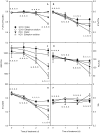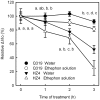Characterization of photosynthetic performance during senescence in stay-green and quick-leaf-senescence Zea mays L. inbred lines
- PMID: 22900069
- PMCID: PMC3416754
- DOI: 10.1371/journal.pone.0042936
Characterization of photosynthetic performance during senescence in stay-green and quick-leaf-senescence Zea mays L. inbred lines
Abstract
The net photosynthetic rate, chlorophyll content, chlorophyll fluorescence and 820 nm transmission were investigated to explore the behavior of the photosynthetic apparatus, including light absorption, energy transformation and the photoactivities of photosystem II (PSII) and photosystem I (PSI) during senescence in the stay-green inbred line of maize (Zea mays) Q319 and the quick-leaf-senescence inbred line of maize HZ4. The relationship between the photosynthetic performance and the decrease in chlorophyll content in the two inbred lines was also studied. Both the field and laboratory data indicated that the chlorophyll content, net photosynthetic rate, and the photoactivities of PSII and PSI decreased later and slower in Q319 than in HZ4, indicating that Q319 is a functional stay-green inbred line. In order to avoid the influence of different development stages and environmental factors on senescence, age-matched detached leaf segments from the two inbred lines were treated with ethephon under controlled conditions to induce senescence. The net photosynthetic rate, light absorption, energy transformation, the activities of PSII acceptor side and donor side and the PSI activities decreased much slower in Q319 than in HZ4 during the ethephon-induced senescence. These results suggest that the retention of light absorption, energy transformation and activity of electron transfer contribute to the extended duration of active photosynthesis in Q319. Although the chlorophyll content decreased faster in HZ4, with decrease of chlorophyll content induced by ethephon, photosynthetic performance of Q319 deteriorated much more severely than that of HZ4, indicating that, compared with Q319, HZ4 has an advantage at maintaining higher photosynthetic activity with decrease of chlorophyll although HZ4 is a quick-leaf-senescence inbred line. We conclude that attention should be paid to two favorable characteristics in breeding long duration of active photosynthesis hybrids: 1) maintaining more chlorophyll content during senescence and 2) maintaining higher photosynthetic activity during the loss of chlorophyll.
Conflict of interest statement
Figures







References
-
- Nelson JC (1988) Genetic associations between photosynthetic characteristics and yield: review of the evidence. Plant physiology and biochemistry 26: 543–554.
-
- Evans JR (1988) Acclimation by the thylakoid membranes to growth irradiance and the partitioning of nitrogen between soluble and insoluble proteins. Australian Journal of Plant Physiology 15: 93–106.
-
- Spano G, Di Fonzo N, Perrotta C, Platani C, Ronga G, et al. (2003) Physiological characterization of ‘stay green’ mutants in durum wheat. Journal of Experimental Botany 54, 1415–1420. - PubMed
-
- Tollenaar M, Daynard TB (1978) Leaf senescence in short-season maize hybrids. Canadian journal of science 58: 869–874.
-
- Wolfe DW, Henderson DW, Hsiao TC, Alvino A (1988) Interactive water and nitrogen effects on senescence of Maize. I. leaf area duration, nitrogen distribution, and yield. Agronomy Journal 80: 859–864.
Publication types
MeSH terms
Substances
LinkOut - more resources
Full Text Sources

